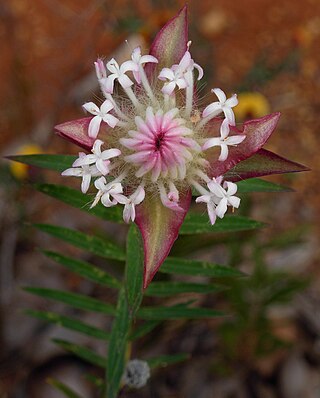
Pimelea spectabilis, or bunjong, is a species of flowering plant in the family Thymelaeaceae and is endemic to the south-west of Western Australia. It is an erect shrub with very narrowly elliptic leaves and heads of white, pale pink or pale yellow flowers surrounded by 4 or 6 egg-shaped involucral bracts.
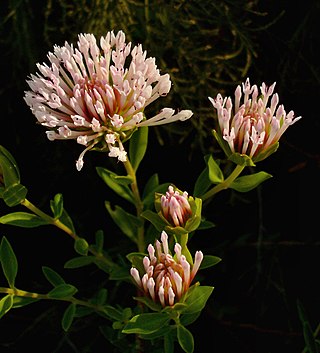
Pimelea calcicola is a species of flowering plant in the family Thymelaeaceae and is endemic to part of the west coast of Western Australia. It is an erect to spreading shrub with elliptic leaves arranged in opposite pairs, and head-like racemes of pale to deep pink, tube-shaped flowers surrounded by leaf-like involucral bracts.

Pimelea ferruginea, commonly known as pink rice flower or coastal banjine, is a species of flowering plant in the family Thymelaeaceae and is endemic to near-coastal areas of south-western Western Australia. It is a dense, erect shrub with elliptic to narrowly elliptic leaves and head-like clusters of pale to deep pink, tube-shaped flowers.

Pimelea serpyllifolia, commonly known as thyme riceflower, is a species of flowering plant in the family Thymelaeaceae and is endemic to southern Australia. It is an erect shrub with narrowly elliptic to spatula-shaped leaves, and compact heads of 4 to 12 yellow, yellowish-green or white flowers surrounded by 2 or 4 leaf-like involucral bracts. Male and female flowers are borne on separate plants.
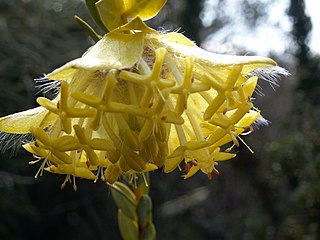
Pimelea suaveolens, commonly known as scented banjine, is a slender shrub with large, rather hairy yellow inflorescences. It occurs in forest areas of the south-west of Western Australia from New Norcia to Albany.
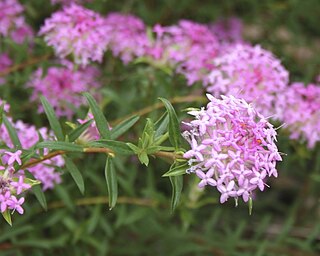
Pimelea rosea, commonly known as rose banjine, is a species of flowering plant in the family Thymelaeaceae and is endemic to the south-west of Western Australia. It is an erect shrub with narrowly elliptic leaves, and clusters of pale pink to reddish-purple flowers surrounded by 4 egg-shaped involucral bracts.
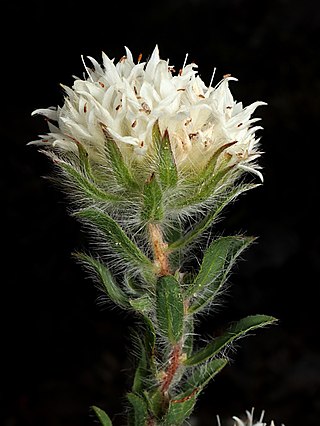
Pimelea imbricata is a species of flowering plant in the family Thymelaeaceae and is native to the southwest of Western Australia and south-eastern South Australia. It is a shrub with narrowly elliptic leaves and erect, compact clusters of white or pink flowers surrounded by 10 to 22 green or red to purple involucral bracts.
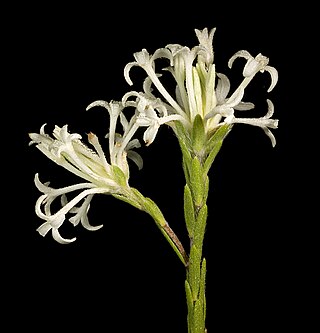
Pimelea longiflora is a species of flowering plant in the family Thymelaeaceae and is endemic to the southwest of Western Australia. It is an erect, spindly shrub with linear to narrowly elliptic leaves and erect clusters of white to cream-coloured flowers, surrounded by 4 to 6 green, egg-shaped involucral bracts.
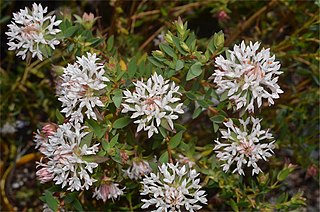
Pimelea sylvestris is a species of flowering plant in the family Thymelaeaceae and is endemic to the south-west of Western Australia. It is an erect shrub with narrowly elliptic to elliptic leaves arranged in opposite pairs, and compact heads of white or pink flowers surrounded by 2 or 4 pairs of narrowly egg-shaped involucral bracts.
Pimelea brevifolia is a species of flowering plant in the family Thymelaeaceae and is endemic to the south-west of Western Australia. It is an undershrub or shrub with erect, elliptic leaves, and heads of white flowers surrounded by four involucral bracts.

Pimelea brevistyla is a species of flowering plant in the family Thymelaeaceae and is endemic to the south-west of Western Australia. It is a shrub with narrowly egg-shaped leaves arranged in opposite pairs, and head-like racemes of white, tube-shaped flowers surrounded by yellowish involucral bracts.

Pimelea cracens is a species of flowering plant in the family Thymelaeaceae and is endemic to the southwest of Western Australia. It is an erect, spindly shrub with narrowly elliptic to egg-shaped leaves and creamy green to pale yellow flowers surrounded by 6 or 8 yellowish or pale green and reddish involucral bracts.
Pimelea erecta is a species of flowering plant in the family Thymelaeaceae and is endemic to the southwest of Western Australia. It is an erect, often spreading shrub with elliptic to egg-shaped leaves arranged in opposite pairs, and clusters of erect, white or pale pink flowers.
Pimelea graniticola is a species of flowering plant in the family Thymelaeaceae and is endemic to the southwest of Western Australia. It is a shrub with linear leaves and large clusters of erect, cream-coloured or white flowers surrounded by about 40 green involucral bracts.
Pimelea lanata is a species of flowering plant in the family Thymelaeaceae and is endemic to the southwest of Western Australia. It is a shrub with narrowly elliptic leaves and erect clusters of white to deep pink flowers surrounded by 4, mostly green, involucral bracts.

Pimelea leucantha is a species of flowering plant in the family Thymelaeaceae and is endemic to near-coastal areas in the west of Western Australia. It is a shrub with linear to narrowly egg-shaped or narrowly elliptic leaves and clusters of white to pale yellow flowers surrounded by 4 or 6 egg-shaped involucral bracts.
Pimelea neokyrea is a species of flowering plant in the family Thymelaeaceae and is endemic to the southwest of Western Australia. It is a low, spreading shrub with narrowly egg-shaped to narrowly ellipic leaves and erect clusters of white or pale yellow flowers surrounded by egg-shaped involucral bracts. It was previously included in Pimelea avonensis.
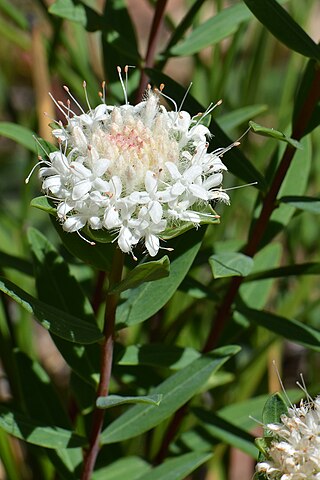
Pimelea rara, commonly known as summertime pimelea, is a species of flowering plant in the family Thymelaeaceae and is endemic to the southwest of Western Australia. It is a shrub with elliptic or egg-shaped leaves, the narrower end towards the base, and heads of white flowers surrounded by 4 broadly egg-shaped involucral bracts.

Pimelea spiculigera is a species of flowering plant in the family Thymelaeaceae and is endemic to Western Australia. It is an erect shrub with linear to narrowly egg-shaped leaves and heads of yellow or greenish-yellow flowers surrounded by 2 or 4 egg-shaped involucral bracts.

Pimelea tinctoria is a species of flowering plant in the family Thymelaeaceae and is endemic to the south-west of Western Australia. It is an erect, spindly shrub with elliptic leaves arranged in opposite pairs, and compact heads of many yellow or yellowish-green flowers usually surrounded by 4 to 7 pairs of egg-shaped to narrowly elliptic yellow and green involucral bracts.















